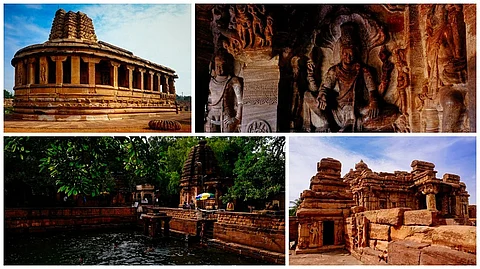

The powerful Chalukya dynasty ruled most of the Deccan between the 6th and 12th centuries. The Kadamba dynasty, that had reigned for nearly two centuries until then, was overthrown by a chieftain named Pulakeshin I, ushering in the Chalukyan era. For his capital, Pulakeshin I chose Badami (known as Vatapi originally) and his lineage came to be known as the Badami Chalukyas. There were three distinct branches of the Chalukyas - the Badami Chalukyas, the Eastern Chalukyas with their capital in Vengi (near Eluru in Andhra Pradesh), and the Kalyani Chalukyas who came later, based in Basavakalyan (near Bidar in Karnataka).
The Badami Chalukya empire flourished between the 6th and 8th centuries. It included most of present day Karnataka and Andhra Pradesh, and at one point, extended all the way up to Gujarat on the west, and Kanchipuram in the south.
The Badami Chalukya rulers were great connoisseurs of art, and the unique style of architecture that took shape under their patronage, combines elements from Nagara architecture seen in northern and central India, and the Dravidian style seen in the southern parts of the country. Today, the architectural legacy of the Badami Chalukyas lives on in the exquisite temples of Aihole, Badami, Mahakuta and Pattadakal, a cluster of small towns in Northern Karnataka. Most of them are Hindu temples dedicated to Lord Shiva, while some are Jain temples.
Aihole, on the bank of the Malaprabha river, is considered a cradle of temple architecture in South India. Scattered around the village, are about a hundred temples, ranging from rock cut shrines to full fledged structural temples, in varying states of preservation. Some of the most iconic structures here include the 6th century Ravana Phadi cave temple, the Huchchimalligudi and Galaganatha groups of temples and the very unusual apsidal (rectangle, with one side replaced by a U) Durga temple, believed to date back to the 7th century.
Durga Temple, Aihole
Huchchimalligudi Temple, Aihole
Ravana Phadi, Aihole
Badami, the capital of the kingdom, is about 35km from Aihole. The huge sandstone cliff that dominates this town has four magnificent cave temples gouged into it. The almond (or badam) colour of the stone is said to give Badami its present name. Every cave has a beautiful pillared mantapa in front, and a sanctum at the back, hewn deep into the rock. The caves are stacked vertically - the lowest one is dedicated to Lord Shiva, the next two to Lord Vishnu, and the topmost is a Jain shrine dedicated to Lord Mahavira. The caves are decorated with breathtaking sculptures of the deities they venerate, and face the expansive Agastya lake. Across the lake is the Bhootanatha group of temples, built by the Badami Chalukyas, with later additions by the Kalyani Chalukyas.
Cave dedicated to Vishnu, Badami
Jaina Cave, Badami
Mahakuta, about 15km from Badami, was an important Chalukya center that played a big role in deciphering the history of the dynasty. It was amidst a cluster of temples here, that the Mahakuta Pillar was found, with inscriptions in Sanskrit and Old Kannada replete with information about the Badami Chalukyas. The beautiful temples here are worth a visit if you have an hour or two to spare. If you want to see the pillar, however, it is to the Archaeological museum in Bijapur that you need to head.
Mahakuta group of temples
The temples in Pattadakal, 22km from Badami, are visibly more refined than their precursors, and symbolize the zenith of Badami Chalukya architecture. This town, also on the bank of the Malaprabha river, was considered very auspicious, and the rulers of the dynasty were coronated here. There are ten main structures here - nine Hindu temples dedicated to Lord Shiva, and one Jain temple. Some of these are built in the Dravidian style, with trademark pyramidal shikharas, and the rest in the Nagara style, with gently convex shikharas. They are all built in red sandstone, and date back to the 7th and 8th centuries.
The most important temples here are the Dravidian style Virupaksha and Mallikarjuna temples. In the mid 8th century, the Badami Chalukya ruler Vikramaditya II won Kanchipuram from the Pallavas. To commemorate his victory, his wife Queen Trilokyamahadevi, commissioned the Virupaksha temple. It is an absolute gem, decorated with intricate carvings depicting scenes from Hindu mythology, including the epics Mahabharata and Ramayana. The smaller but equally impressive Mallikarjuna Temple that stands adjacent to it, was built by the king’s second queen. The group of monuments at Pattadakal was inscribed on UNESCO’s list of World Heritage Sites in 1987.
Pattadakal group of temples
Pattadakal group of temples
Pattadakal group of temples
The reign of the Badami Chalukyas ended in the late 8th century, when the last king Kirtivarman II was displaced by the Rashtrakuta dynasty.